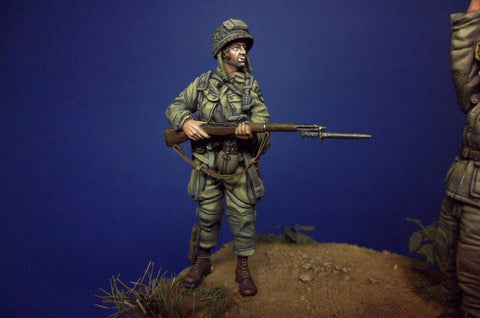All
Division Miniatures 1:35 Resin Figure - U.S. 101st Airborne, Normandy 1944
Sold Out
Division Miniatures 1:35 Resin Figure - U.S. 101st Airborne Division, Normandy 1944 - Resin Figure #35-062
During the Second World War, the 101st Airborne Division was renowned for its role in the D-Day airborne landings on June 6, 1944 in Normandy. The division's objectives included securing the four causeway exits behind Utah Beach, destroying a German coastal artillery battery at Saint-Martin-de-Varreville, capturing a number of buildings, footbridges, destroying highway bridges and more. The 101st Airborne Division managed to secure the beach exits, which was its most important mission, as well as disrupt German communications and establish roadblocks to impede the movement of German reinforcements.
The kit includes one unassembled unpainted resin figure of a U.S. Army soldier from the 101st Airborne Division during the Operation Overlord in 1944.
Division Miniatures 1:35 Resin Figure - Modern US Sniper
Sold Out
Division Miniatures 1:35 Resin Figure - Modern US Sniper .50 Cal - Resin Figure #35-093
US Army and Marine Snipers normally operate in small teams. This can consist of a Sniper/Spotter or a Sniper, Spotter and Flanker. The Sniper carries out the long range shooting with the support and shot assessment from the Spotter, while the Flanker provides security.
The kit includes one unpainted resin figure of a US Army/Marine Sniper with a Barrett .50 cal long range rifle.
Division Miniatures 1:35 Resin Figure - Modern US Spotter
Sold Out
Division Miniatures 1:35 Resin Figure - Modern US Spotter - Resin Figure #35-094
A spotter assists his partner in observing of targets, judging weather/atmospheric conditions and conducts supporting tasks such as security of the location, comms; calling for artillery and close air support.
The kit includes one unpainted resin figure of an American Spotter, also included is a silenced M4 Carbine, Backpack and Camera/Optics bag, a Spotting Scope and a piece of wall scenery for use on the base/diorama.
Division Miniatures 1:35 Resin Figure - US Army/Marine L.R.R.P (Vietnam)
Sold Out
Division Miniatures 1:35 US Army/Marine L.R.R.P. (Vietnam) - Resin Figure #35-048
L.R.R.P. or Long Range Reconnaissance Patrol units were first used during the Vietnam war by the 101st Airborne Division in 1965. Various Infantry Divisions followed suit and by 1966 all Infantry Divisions had been authorised to establish their own L.R.R.P. unit. Training to become a L.R.R.P. soldier was strenuous and training staff were often Special Forces trained soldiers that had graduated from the infamous 'Recondo School' in Nha Trang. The USMC also used Force Recon and Battalion Recon teams to conduct long ranged recon operations. USMC Recon teams were normally larger in size and more heavily armed, unlike their Army and SF counterparts, Marine Recon did not commonly use indigenous Montagnards as scouts.
In 1969 all Army 'Lurps' were merged into the 75th Infantry Regiment (Ranger).
The kit includes one unpainted resin figure of an American L.R.R.P. soldier with Alice pack and Colt Carbine.
Division Miniatures 1:35 Resin Figure - US Marine Sniper (Vietnam)
Sold Out
Division Miniatures 1:35 US Marine Sniper (Vietnam) - Resin Figure #35-046
US Marine Corps infantrymen and reconnaissance Marines graduated from the US Marine Corps Scout Sniper School are known as Scout Snipers. In order to get this designation, the snipers must be conferred the rank of Lance Corporal, be selected to enter the scout-sniper platoon, and finish a special training course.
The main skills of a USMC Scout Sniper include fieldcraft, marksmanship and map-reading. The primary battlefield role of the sniper is to support the infantry battalion by executing aimed fire on selected targets as well as to perform reconnaissance and surveillance tasks.
The kit is based on a photo of Lance Corporal Dalton Gunderson 3rd Marine Division scanning the area for VC snipers with a Winchester Model 70 during Operation Virginia in 1966. This picture is often misattributed as being Carlos Hathcock, a legendary sniper of the US Marine Corps. During the Vietnam War, Hathcock killed at least 93 Vietnamese soldiers. At that time an officer had to witness the kills to confirm them. That made the confirmation difficult as officers could not be present every time a sniper shot the enemy. Hathcock asserted that he had killed over 300 men in Vietnam.
The kit includes one unpainted resin figure of an American USMC sniper and a Winchester Model 70 sporting rifle (unofficially issued in Vietnam and used by Hathcock and others during his first tour).
Division Miniatures 1:35 Resin Figure - German Waffen SS Tank Crew 1944 WWII
Sold Out
Division Miniatures 1:35 German SS Tank Crew 1944 WWII - Resin Figure #DT35-036 - 3EA (2 Heads)
The Waffen SS had three Panzer Battalions: the 101st, 102nd and 103rd SS Heavy Panzer Battalion. These were renamed in 1944 as SS Heavy Panzer Battalion 501, 502 and 503 respectively (in German Schwere SS-Panzer-Abteilung 503). Each Battalion employed Tiger I and Tiger II tanks at varying stages of the war, the latter was introduced in 1944.
The kit includes one unpainted resin figure of a German SS Tank Crew soldier and comes with 2 head variants as pictured, one wearing the M1943 field cap and the other an overseas cap. Either were worn by Officers or Enlisted men, with variations to the silver piping on the overseas cap often being the only marked difference. See here for more useful details on getting the uniforms right.
Division Miniatures 1:35 Resin Figure - German Gebirgsjäger (Mountain Infantry) WWII
Sold Out
Division Miniatures 1:35 German Gebirgsjäger, Mountain Infantry, WWII - Resin Figure #35-053
The light infantry section of German and Austrian alpine troops are called Gebirgsjäger (Jäger - 'hunter'). The Gebirgsjäger, along with German paratroopers, are considered the elite infantry units of the German Army.
During the Second World War, the Gebirgsjäger units were lightly equipped and often used mules as their transport. Mountain infantry men carried fewer automatic weapons than regular infantry and could be identified by the edelweiss insignia on their sleeves and caps. Machine gunners usually had more ammunition than the regular infantry.
The Gebirgsjäger troops took part in a number of WWII battles, including the Gothic Line, the invasion of Crete, the operations in the Caucasus and others.
The kit includes one unpainted resin figure of a German soldier.



















































